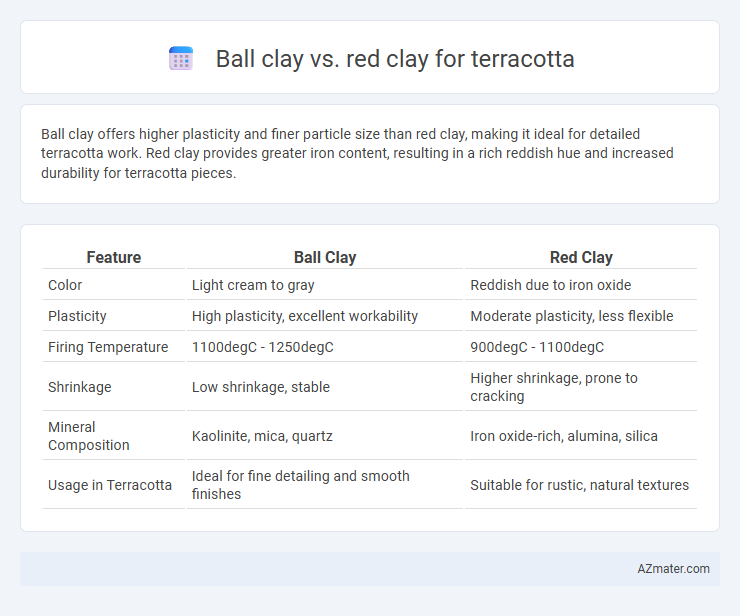Ball clay offers higher plasticity and finer particle size than red clay, making it ideal for detailed terracotta work. Red clay provides greater iron content, resulting in a rich reddish hue and increased durability for terracotta pieces.
Table of Comparison
| Feature | Ball Clay | Red Clay |
|---|---|---|
| Color | Light cream to gray | Reddish due to iron oxide |
| Plasticity | High plasticity, excellent workability | Moderate plasticity, less flexible |
| Firing Temperature | 1100degC - 1250degC | 900degC - 1100degC |
| Shrinkage | Low shrinkage, stable | Higher shrinkage, prone to cracking |
| Mineral Composition | Kaolinite, mica, quartz | Iron oxide-rich, alumina, silica |
| Usage in Terracotta | Ideal for fine detailing and smooth finishes | Suitable for rustic, natural textures |
Introduction to Ball Clay and Red Clay
Ball clay is a highly plastic, fine-grained sedimentary clay known for its excellent workability and favorable firing properties, often used in the production of ceramic items including terracotta. Red clay contains iron oxide, giving it a distinctive reddish hue and moderate plasticity, commonly utilized for terracotta due to its natural color and durability. Both clays differ significantly in mineral composition and firing temperature, influencing the texture and strength of terracotta products.
Key Differences Between Ball Clay and Red Clay
Ball clay contains a high proportion of kaolin and possesses plasticity that allows for excellent workability, making it ideal for detailed terracotta products. Red clay, rich in iron oxide, imparts a characteristic reddish hue and has less plasticity but offers greater durability when fired. The primary differences lie in their mineral composition, color after firing, plasticity, and suitability for different terracotta applications.
Mineral Composition of Ball Clay vs Red Clay
Ball clay contains a high percentage of kaolinite (20-80%), mica, and quartz, providing excellent plasticity and fine particle size that enhance the workability and strength of terracotta. Red clay is rich in iron oxide (Fe2O3), which gives it its characteristic reddish color and affects its thermal properties, but typically has lower kaolinite content and coarser particles. The contrasting mineral compositions dictate ball clay's superior plasticity and red clay's distinct hue and firing characteristics in terracotta production.
Plasticity and Workability in Terracotta Applications
Ball clay exhibits superior plasticity compared to red clay, making it highly suitable for intricate terracotta molding and detailed decorative work. Its fine particle size and high kaolinite content enhance workability, allowing artists to achieve smooth surfaces and complex shapes with ease. In contrast, red clay, while more abundant and affordable, has lower plasticity, often requiring blending with ball clay to improve its flexibility and reduce cracking during drying and firing in terracotta applications.
Firing Temperatures and Color Outcomes
Ball clay typically fires at a lower temperature range of 1100degC to 1200degC, producing a smooth, off-white to light gray body ideal for refined terracotta pieces. Red clay requires higher firing temperatures, usually between 1150degC and 1300degC, resulting in a warm reddish-brown to deep terracotta hue due to its iron oxide content. The choice between ball clay and red clay directly impacts the durability and color vibrancy of terracotta, with ball clay offering greater plasticity and red clay providing richer, earth-toned finishes.
Strength and Durability of Finished Terracotta
Ball clay, known for its high plasticity and fine particle size, enhances the strength and durability of finished terracotta by improving moldability and reducing shrinkage during firing. Red clay, with its coarser texture and iron content, offers natural color but tends to produce terracotta with lower mechanical strength and increased brittleness. Combining ball clay with red clay can optimize terracotta strength and durability, balancing workability with structural integrity.
Common Uses in Pottery and Sculpture
Ball clay is prized in pottery and sculpture for its plasticity and fine particle size, making it ideal for intricate, detailed terracotta pieces and refined ceramics. Red clay, rich in iron oxide, is commonly used for traditional terracotta ware, outdoor garden sculptures, and large pottery due to its durability and distinct reddish hue after firing. Both clays contribute uniquely to terracotta art: ball clay enhances workability and surface finish, while red clay provides strength and characteristic earthy color.
Pros and Cons of Ball Clay for Terracotta
Ball clay offers exceptional plasticity and strength, making it ideal for detailed terracotta work and reducing the risk of cracking during drying and firing. Its fine particle size enhances the smooth texture of terracotta but can increase shrinkage and warping if not properly balanced with coarser clays like red clay. While ball clay provides superior workability and durability, it often requires blending with red clay to achieve optimal porosity and color characteristic of traditional terracotta.
Pros and Cons of Red Clay for Terracotta
Red clay for terracotta offers excellent plasticity, making it ideal for detailed shaping and molding, but it tends to have higher shrinkage rates that can lead to cracking during drying and firing. Its rich iron content provides a distinctive warm red color, enhancing the aesthetic appeal of finished terracotta products, although this can result in uneven color tones due to variations in firing temperature. Red clay's porous nature improves breathability and moisture absorption in terracotta, but it also reduces durability compared to less porous clays like ball clay.
Choosing the Right Clay for Your Terracotta Project
Ball clay offers high plasticity and fine particle size, making it ideal for detailed terracotta work and smooth finishes, while red clay is valued for its rich iron content that imparts a warm, natural color and robust strength. Selecting the right clay depends on the project's desired texture, color, and firing temperature; ball clay suits intricate designs requiring smoothness, whereas red clay enhances rustic aesthetics and durability. Evaluating the balance between workability and final appearance ensures the best results for terracotta crafts.

Infographic: Ball clay vs Red clay for Terracotta
 azmater.com
azmater.com